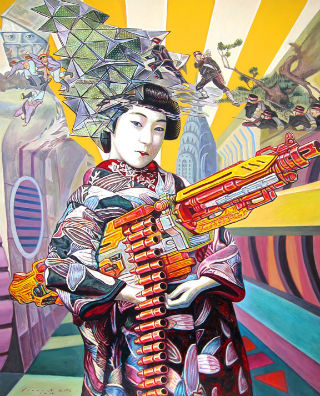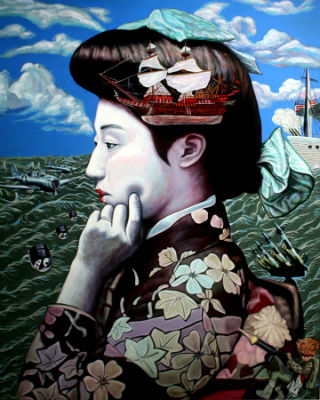Filtered By: Cbb
Community Bulletin Board
Exploring contradictions via contemporary art

Banzai!, a 4 x 5 foot painting, takes its name from the traditional war cry shouted by members of the Japanese Imperial Army during World War II.
These are paintings about war, yet they are anti-war.
They express reverence and awe for Japanese culture, yet they take strong positions against the war-mongering nature of the samurai class and the military clique that lorded over Japan for centuries. The contradictions of a love-hate relationship between the Philippines and its Northern neighbor are re-examined in the eight major paintings in canvas and twenty smaller works on paper by artist Vincent de Pio in a show titled Banzai! The son of Gig de Pio, one of the country's foremost portraitists, Vincent is a product of the College of Fine Arts of the University of the Philippines. Originally enamoured with painting classical women cellists in the pursuit of their craft, he began exploring other images and vestiges of art such as ballerinas before entering into the enchanted world of the Japanese geisha. From his explorations of the world of the geishas, de Pio dug deeper and became interested in other aspects of Japanese culture such as Japanese noblemen and ladies and inevitably the world of the samurai.
The paintings in this exhibit explore not only cultural conflicts, but consider economic and geo-political tensions as well. Banzai!, a 4 x 5 foot painting, takes its name from the traditional war cry shouted by members of the Japanese Imperial Army during World War II. Although it literally meant "long life" or "10,000 years", it was appropriated by samurais and eventually soldiers to mean "Long Live the Emperor" or a life after victory. In this painting, De Pio depicts a handsomely attired Japanese female figure in an intricately designed kimono holding a 30 caliber machine gun. There are the yellow rays of the rising sun in the background. She is aptly made up kabuki style but there are images of soldiers running towards an emerald grinder and coming out falling like flies.The bullets in the machine gun are strangely inverted as if the main character is ready to shoot herself. There is, in the background, the everwatchful pair of eyes, perhaps those of the Emperor monitoring the unfolding scene. To the rear, is the image of the Chrysler building, the artists commenting that perhaps even in today's age, the World War that was, continues today, not in the field of force and violence but in the economic arena.

Tora! Tora! Tora! (the code words meaning Tiger! Tiger! Tiger! which signalled the beginning of the attack on Pearl Harbor) has an innocent looking and bedimpled geisha in mid-thought.
One will note that de Pio does not hold any punches in delving directly into his love-hate relationship with Japanese culture. Tora! Tora! Tora! (the code words meaning Tiger! Tiger! Tiger! which signalled the beginning of the attack on Pearl Harbor) has an innocent looking and bedimpled geisha in mid-thought. But, unlike the infamous attack on the American naval base, in this de Pio painting, the shoe is on the other foot. American Mustang fighter planes are now dropping smiling bombs at this icon of Japanese femininity. The painting tells many stories and allows the viewer to make their own. Why the wooden ship and the handkerchief on her head? Is this metaphoric of the Japanese loss of innocence during World War II or an implication that the much-vaunted Japanese naval machinery then proved to be nothing more that a mere "paper tiger."
The Rising Sun is a painting that is exactly what it is not. It shows a samurai with an atomic explosion on his head and bombs blasting in the background and all around the rising sun. Peace Pipe has a kimono-ed lady smoking on an intercontinental ballistic missile. Other works include The Code of the Bushido depicting a samurai lady bidding her lord goodbye faced with the oracle showing the foretelling of war and violence to come. Sayonara, Kiss Your Ass Goodbye features a fragile looking geisha complete with paper umbrella traversing the stormy seas of war while cradling a smiling nuclear warhead. The collection is completed with The Capture of the Three Star General featuring his three favorite geishas, one of them in the midst of make-up, another getting ready for their regular rituals while the third figure is armed to the teeth with an automatic weapon.
.jpg)
Peace Pipe has a kimono-ed lady smoking on an intercontinental ballistic missile.
This exhibition is at once a statement about Asian culture as it has been, as it is and as it will be and marks a high point in the artist's career. The exhibit opens at Galerie Joaquin on Thursday, October 18, 2012 at 6:30 P.M. and runs until October 31. Galerie Joaquin is located at 371 P. Guevarra Street corner Montessori Lane, Addition Hills, San Juan City, Metro Manila. For more information, call 723-9418, 723-9253, email info@galeriejoaquin.com or visit their website. Press release and photos from Galerie Joaquin
Tags: vincentdepio, artexhibit
More Videos
Most Popular




